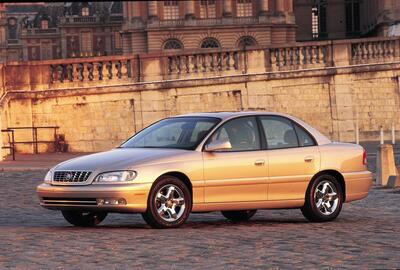New Car/Review
Cadillac Catera Sport
SEE ALSO: Cadillac Buyer's Guide
By Tom Hagin
SPECIFICATIONS Manufacturer's Suggested Retail Price $ 30,860 Price As Tested $ 35,763 Engine Type DOHC 24-valve 3.0 Liter V6 w/SMFI* Engine Size 181 cid/2962 cc Horsepower 200 @ 6000 RPM Torque (lb-ft) 192 @ 3400 RPM Wheelbase/Width/Length 107.5"/70.3"/192.2" Transmission Four-speed automatic Curb Weight 3795 pounds Fuel Capacity 16.0 gallons Tires (F/R) P235/45R17 H-rated mud & snow Brakes (F/R) Disc (ABS)/disc (ABS) Drive Train Front-engine/rear-wheel-drive Vehicle Type Five-passenger/four-door Domestic Content N/A Coefficient of Drag (Cd.) 0.33 PERFORMANCE EPA Economy, miles per gallon city/highway/average 18/24/20 0-60 MPH 9.0 seconds 1/4 (E.T.) 17.0 seconds @ 82.5 mph Top-speed 120 mph * Sequential multi-port fuel injection
Cadillac is to be commended for filling a void in its lineup quickly with its mid-sized, rear-drive Catera in 1996. The company needed this vehicle to reach America's affluent baby-boomer population. The car is built and engineered in Germany.
Catera comes as one model only, although this year a Sport package has been added, and we test one this week.
OUTSIDE -Cadillac took no chances with Catera's styling. Some have accused it of appearing bland, but the majority of automakers produce no-risk styles for cars in this range. Its exterior shape has been freshened for 2000 with a new hood, fenders and front fascia and a different rear deck lid. The rear light assemblies are also new and the tail lamps have been split into two sections instead of one solid mass of reflectors. On Cateras with the Sport package, ground effects-type rocker panel extensions, a large spoiler and 17-inch, five spoke alloy wheels give it a lower, more muscular look. Also part of the Sport package are larger, high intensity discharge (HID) headlamps.
INSIDE -Due to its large cabin with lots of glass, the view from inside Catera is panoramic. Only its large C-pillars block a bit of vision to the right and left rear of the car. Catera's interior is large enough for four passengers to ride comfortably, although a fifth can be transported in a pinch. Leg, head and shoulder room is excellent in Catera's back seat, but toe room under the front seats is tight. Both the front and rear seats are well contoured, firm and with extra bolstering in the Sport package. New this year is a redesigned instrument panel with a different texture and more angular lines than the original. Its new center console now has an extra 12-volt power port and integrated cupholders. In back are more new cupholders and a child seat tether. Standard amenities include electronic climate control, power windows, mirrors and programmable door locks, automatic headlights, cruise control, OnStar system, rear window defogger, fog lights, tilt steering and an AM/FM/Cassette stereo. Our test car had a power sunroof and an 8-speaker uplevel stereo system. Both are optional.
ON THE ROAD -For a Cadillac, Catera has a unique engine layout. All other Caddy models (except the Escalade) use a front-wheel drive powertrain but Catera uses a more traditional front engine, rear-drive layout. Its engine is a 24 valve, dual-overhead-cam 3.0 liter V6 that produces 200 horsepower and 192 lb-ft of torque. The addition of electronic throttle control and a revised torque converter has improved off-line launch a bit. In a car that weighs nearly two tons, we'd welcome a bit of additional power, however. Its four-speed automatic transmission has three settings: Winter mode starts the car off in third gear to reduce wheelspin on icy roads; Sport mode produces quick, firm and decisive gear changes; Normal mode saves fuel and forces the gearbox to upshift faster. Traction control, another system that further reduces wheelspin on slippery roads, is standard.
BEHIND THE WHEEL - Catera rides on unit body construction that is stiff and built for safety but "tweaks" to the new model's suspension have increased Catera's fun quotient. It uses traditional MacPherson struts up front and a rear multilink setup and both ends are fitted with coil springs, tube shocks and an anti-roll bar. This layout does an admirable job of soaking up road imperfections, while Sport models, which have a stiffer suspension system than the base model, now handles the task of controlling body motions better than before. The addition of "gripper" Goodyear Eagle tires to the Sport model has increased traction, while its speed-sensitive recirculating ball steering system offers crisp turn-in and a nicely weighted feel. Braking duties are taken care of by large four-wheel disc brakes with a standard anti-lock braking system (ABS).
SAFETY - Dual dashboard and side airbags, ABS, traction control and child seat tethers are standard.
OPTIONS - Sport Package: $2000; Power sunroof: $995; Power rear window sunshade: $295; Uplevel Bose-brand stereo: $973;



